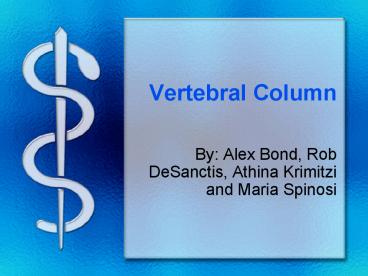Lordosis & Kyphosis Scoliosis a sideways curvature of - PowerPoint PPT Presentation
1 / 26
Title:
Lordosis & Kyphosis Scoliosis a sideways curvature of
Description:
... Lordosis & Kyphosis Scoliosis a sideways curvature of the spine. These curves are often S- or C-shaped. Lordosis inward curve of the lumbar spine ... – PowerPoint PPT presentation
Number of Views:1525
Avg rating:3.0/5.0
Title: Lordosis & Kyphosis Scoliosis a sideways curvature of
1
Vertebral Column
- By Alex Bond, Rob DeSanctis, Athina Krimitzi and
Maria Spinosi
2
Name the Parts of the Vertebral column
3
Spine
- 5 regions
- Function axial support for the body and balance
- Protect spinal cord
- Flexible motion
- Also known as vertebral column
4
Cervical Vertebrae
- 7 cervical vertebrae
- Identified as C1-C7
- First 2 are called atlas and axis because they
perform different functions
5
Thoracic
- Larger than cervical vertebrae
- Articulate to ribs
- T1-T12
6
Lumbar
- L1-L5
- Massive block-like bodies
- Short-hatchet shaped spinous process
- Sturdiest
7
Sacral
- Fusion of 5 vertebrae
- Ala connects to hip
- Forms pelvic posterior wall
- Superior to coccyx
- It is between the two hip bones connecting the
spine to the pelvis - Ends the vertebral canal
8
Coccyx
- Tailbone
- Fusion of 3-5 irreglar invertabrae
- Remnant of the tail that other vertebrae animals
have
9
Explain how the cervical, thoracic, and lumbar
vertebrae differ from one another
10
Cervical
- Neck region
- Protects the brain stem and the spinal cord
- Supports the skull
- Very mobile
- Is responsible for movement of the head
- Allows for a wide range of movement
11
Thoracic
- Thoracic cavity
- Rib attachments and longer spinous processes add
to the thoracic strength - These structures make the thoracic spine more
stable and larger than the cervical or lumbar
regions
12
Thoracic
- Distinguished because they are the only vertebrae
to articulate with the ribs - The spinous process is long and hooks sharply
downward - The rib cage and ligament system limit the
thoracic spines range of motion and protects
vital organs.
13
Lumbar
- Lower back
- Larger range of motion than the thoracic, less
than the cervical - Joints allow for significant flexion and
extension movement but limits rotation
14
Lumbar
- Have massive blocklike bodies
- Short hatchet shaped spinous processes
- Because they have the most stress, they are
sturdiest
15
Discuss the importance of intervertebral discs
and spinal curvatures
16
Intervertebral Discs
- Pads of flexible fibrocartilage which separate
individual vertebrae - Cushion vertebrae, absorb shocks, allow for spine
flexibility
17
Changes in Discs
- Structure changes with age
- In a young person, 90 is water
- Spongy and flexible
- Water content decreases with age, discs become
harder and less compressible - More susceptible to herniated, or slipped,
discs
18
Curvatures
- Discs and S-shaped structure prevent shock to
the head when we walk or run, make the body
flexible
- Primary
- Curvatures of the thoracic and sacral regions
- Present at birth
- C-shape of a newborn
- Secondary
- Curvatures of cervical and lumbar regions
- Develop after birth
- Allow us to center body weight on lower limbs
- Cervical - Baby begins to raise head
- Lumbar - Baby begins to walk
19
(No Transcript)
20
Identify the joints that connect bones of the
vertebral column
21
Facet Joints
- Each vertebra has two sets of facet joints. One
pair faces upward (superior articular facet) and
one downward (inferior articular facet). - There is one joint on each side (right and left).
- Facet joints are hingelike and link vertebrae
together. - They are synovial joints.
- This means each joint is surrounded by a capsule
of connective tissue and produces a fluid to
nourish and lubricate the joint. - The joint surfaces are coated with cartilage
allowing joints to move or glide smoothly
articulate against each other.
22
Lumbo-sacral Joints
- Special joint between S1 and L5
- The lumbosacral region of the spine consists of 5
lumbar vertebrae and the sacrum (5 bones joined
together). - The sacral segment is inclined anteriorly and
inferiorly forms an angel with the horizontal
called the lumbo-sacral angle
23
Explain how the abnormal spinal curvatures differ
from one another
24
Scoliosis, Lordosis Kyphosis
- Scoliosis
- a sideways curvature of the spine. These curves
are often S- or C-shaped. - Lordosis
- inward curve of the lumbar spine (just above the
buttocks). - Kyphosis
- outward curve of the thoracic spine (at the level
of the ribs)
25
Video!
- http//www.spineuniverse.com/anatomy/spinal-anatom
y-animation
26
References
- http//www.coloradospineinstitute.com/subject.php?
pnanatomy-spinalregions14 - http//rebuildhealth.com/casestudy2.html
- http//www.spineuniverse.com/anatomy/facet-joints-
spine-anatomy - http//www.spineuniverse.com/anatomy/spinal-anatom
y-animation - AP Textbook








![❤[PDF]⚡ The Expert’s Tool for Avoiding Eye Contact: Sideways Shuffle (Books Of Books - PowerPoint PPT Presentation](https://s3.amazonaws.com/images.powershow.com/10053419.th0.jpg?_=202406111111)

![[DOWNLOAD]⚡️PDF✔️ The Expert’s Tool for Avoiding Eye Contact: Sideways Shuffle (Books Of Books - PowerPoint PPT Presentation](https://s3.amazonaws.com/images.powershow.com/10046098.th0.jpg?_=20240603061)
![[DOWNLOAD]⚡️PDF✔️ The Expert’s Tool for Avoiding Eye Contact: Sideways Shuffle (Books Of Books - PowerPoint PPT Presentation](https://s3.amazonaws.com/images.powershow.com/10046811.th0.jpg?_=20240604025)
![[DOWNLOAD]⚡️PDF✔️ The Expert’s Tool for Avoiding Eye Contact: Sideways Shuffle (Books Of Books - PowerPoint PPT Presentation](https://s3.amazonaws.com/images.powershow.com/10045795.th0.jpg?_=20240603128)


















